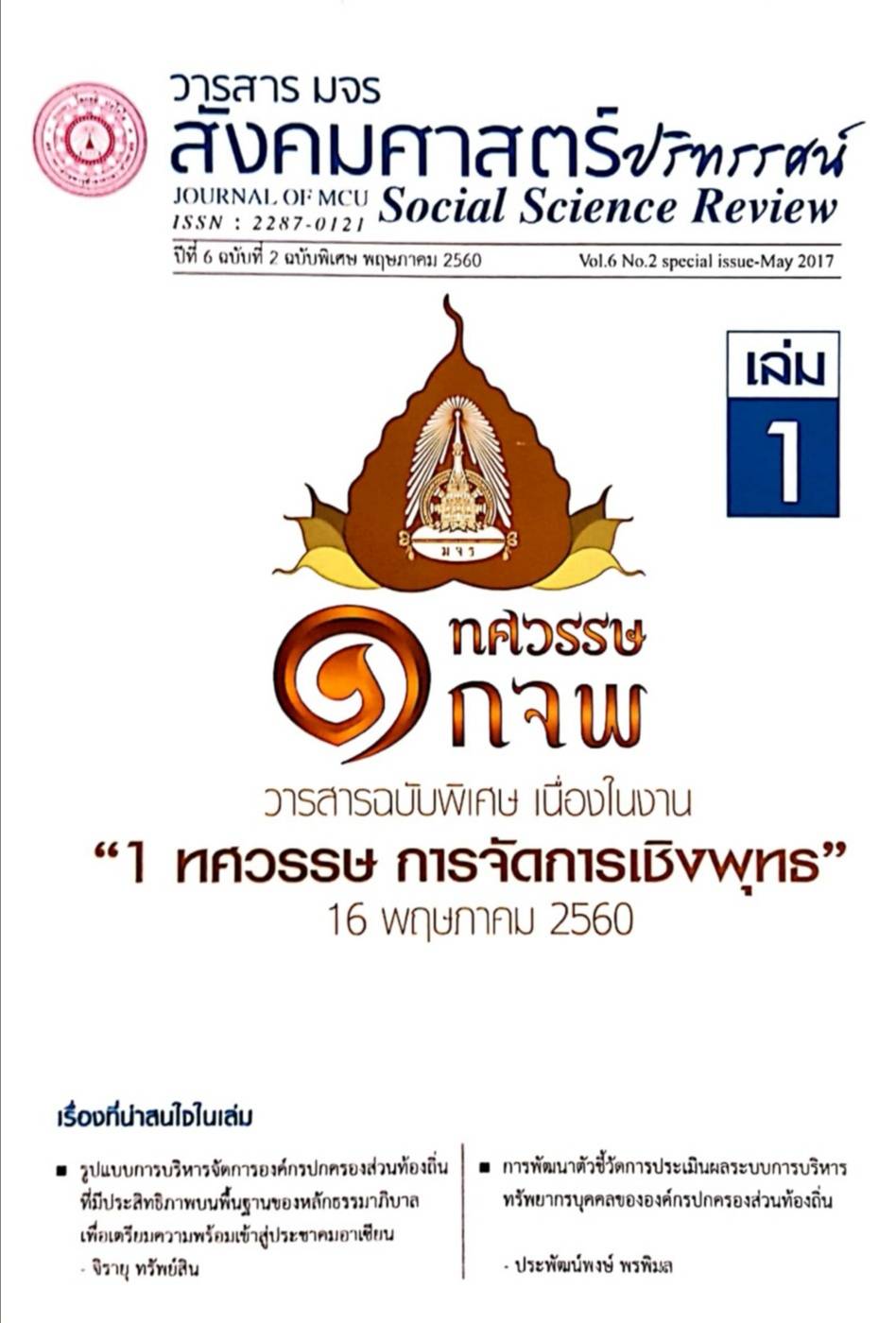รูปแบบการเผยแผ่ธรรมของพระธรรมมังคลาจารย์ (ทอง สิริมงฺคโล)
บทคัดย่อ
บทความว จัยนี้มีวัตถุประสงค์ในการศึกษาดังต่อไปนี้ 1. เพื่อศึกษารูปแบบการเผยแผ่
ธรรมของพระสงฆ์ในคัมภีร์พระพุทธศาสนา 2. เพื่อศึกษารูปแบบการเผยแผ่ธรรมของพระธรรมมัง
คลาจารย์ (ทอง ส ร มงฺคโล) 3. เพื่อน้าเสนอรูปแบบการเผยแผ่ธรรมของพระธรรมมังคลาจารย์ (ทอง
ส ร มงฺคโล) ระเบียบว ธีว จัยเป็นการว จัยเช งคุณภาพ ผู้ว จัยได้ศึกษาจากเอกสาร และการสัมภาษณ์เช ง
ลึกกับผู้ทรงคุณวุฒ จ้านวน 25 รูป/คน และว เคราะห์ข้อมูลแบบพรรณนาความ
ผลการวิจัยพบว่า
1. รูปแบบการเผยแผ่ธรรมของพระสงฆ์ในคัมภีร์พระพุทธศาสนามีทั้ง หมด 8 รูปแบบ
คือ 1. รูปแบบการแสดงธรรม 2. รูปแบบการปฏ บัต ตนให้เป็นที่น่าเลื่อมใสศรัทธา 3. รูปแบบการ
เข้าหาผู้น้า 4. รูปแบการปฏ วัต ค้าสอนของลัทธ และศาสนาดั้งเด ม 5. รูปแบบการปฏ รูปค้าสอน
ดั้งเด ม 6. รูปแบบการใช้ปาฏ หาร ย์ 7. รูปแบบการปรับตัวให้เข้ากับวัฒนธรรมท้องถ่น 8. รูปแบบ
การใช้บุคล กภาพ รูปแบบการเผยแผ่ธรรมดังกล่าวนั้นท้าให้ประชาชนจ้านวนมากหันมาให้ความ
สนใจและนับถือพระพุทธศาสนา และเจร ญรุ่งเรืองมาจนถึงปัจจุบันนี้
2. รูปแบบการเผยแผ่ธรรมของพระธรรมมังคลาจารย์ (ทอง ส ร มงฺคโล) เป็นรูปแบบการ
เผยแผ่ธรรมที่ผสมผสานระหว่างรูปแบบการเผยแผ่ธรรมของพระสงฆ์ในสมัยพุทธกาลกับรูปแบบ
สมัยใหม่ โดยจะเน้นสอนหลักธรรมที่ส้าคัญ ส่งเสร มให้บุคคลบวชเข้ามาเป็นพระภ กษุใน
พระพุทธศาสนา ใช้วัตถุและสื่อสมัยใหม่เป็นอุปกรณ์ช่วยในการเผยแผ่ธรรม รูปแบบที่ใช้ในการเผย
แผ่ธรรมนั้น ได้แก่ ศาสนธรรม ศาสนบุคคล ศาสนวัตถุ และสื่อต่าง ๆ รูปแบบการเผยแผ่ธรรม
ดังกล่าวท้าให้ประชาชนจ้านวนมาก ไม่ว่าจะเป็นชาวไทยหรือต่างประเทศ ต่างให้การยอมรับและ
นับถือ 3. รูปแบบการเผยแผ่ธรรมของพระธรรมมังคลาจารย์ (ทอง ส ร มงฺคโล) ได้เก ดประโยชน์
ต่อพระพุทธศาสนาและต่อสังคมหลายด้าน พระสงฆ์และประชาชนจ้านวนมากคาดหวังว่า พระสงฆ์ ในอนาคตควรน้ารูปแบบการเผยแผ่ธรรมดังกล่าวเป็นแนวทางในการเผยแผ่พระพุทธศาสนา
เนื่องจากเป็นรูปแบบการเผยแผ่ธรรมที่เหมาะกับยุคสมัย นอกจากนั้นยังได้น้าเสนอรูปแบบการเผย
ธรรมต่อพระสงฆ์เพื่อเป็นแนวทางในการเผยแผ่พระพุทธศาสนา โดยแบ่งรูปแบบการเผยแผ่ธรรม
ออกเป็น 4 รูปแบบ คือ 1. รูปแบบศาสนบุคคล 2. รูปแบบศาสนธรรม 3.
รูปแบบศาสนวัตถุ 4. รูปแบบศาสนบร การ เพื่อประโยชน์ต่อการเผยแผ่พระพุทธศาสนาและสังคม
ต่อไป
เอกสารอ้างอิง
ปุ้ย แสงฉาย. (2528). มิลินทปัญหา. กรุงเทพฯ: โรงพ มพ์ลูก ส. ธรรมภักดี.
พระครูอุทัยก จจารักษ์. (พฤษภาคม-ส งหาคม 2559). “หลักศีล 5 : การประยุกต์ใช้เพื่อพัฒนา
พฤต กรรมของบุคคลในสังคม”. วารสาร มจร สังคมศาสตร์ปริทรรศน์. 5(2).
พระณปวร โทวาท. (พฤษภาคม-ส งหาคม 2559). “การพัฒนาต้นแบบการเผยแผ่พระพุทธศาสนา
ของศูนย์เผยแผ่พระพุทธศาสนาประจ้าจังหวัดในประเทศไทย”. วารสาร มจร
สังคมศาสตร์ปริทรรศน์. 5(2).
พระพรหมบัณฑ ต (ประยูร ธมฺมจ ตโต). (2558). พระธรรมเทศนา 61 กัณฑ์, กรุงเทพมหานคร:
หจก. สามลดา,
มหาจุฬาลงกรณราชว ทยาลัย. (2539). พระไตรปิฎกฉบับภาษาไทย ฉบับมหาจุฬาลงกรณราช
วิทยาลัย. กรุงเทพฯ: โรงพ มพ์มหาจุฬาลงกรณราชว ทยาลัย,
Luniya, B.N, (1978). Life and Culture in Ancient India. Agra: Lakshmi Narain Agarwal.
Monier Williams. (1920). A Sanskrit English Dictionary. Revised edition, USA: Oxford
University Press.
Walpola Sri Rahula, (2009). What the Buddha Taught. 5th ed., Bangkok: Haw Trai
Roundation.
ดาวน์โหลด
เผยแพร่แล้ว
รูปแบบการอ้างอิง
ฉบับ
ประเภทบทความ
สัญญาอนุญาต
ลิขสิทธิ์ (c) 2020 วารสาร มจร สังคมศาสตร์ปริทรรศน์

อนุญาตภายใต้เงื่อนไข Creative Commons Attribution-NonCommercial-NoDerivatives 4.0 International License.
เพื่อให้เป็นไปตามกฎหมายลิขสิทธิ์ ผู้นิพนธ์ทุกท่านต้องลงลายมือชื่อในแบบฟอร์มใบมอบลิขสิทธิ์บทความให้แก่วารสารฯ พร้อมกับบทความต้นฉบับที่ได้แก้ไขครั้งสุดท้าย นอกจากนี้ ผู้นิพนธ์ทุกท่านต้องยืนยันว่าบทความต้นฉบับที่ส่งมาตีพิมพ์นั้น ได้ส่งมาตีพิมพ์เฉพาะในวารสาร มจร สังคมศาสตร์ปริทรรศน์ เพียงแห่งเดียวเท่านั้น หากมีการใช้ภาพหรือตารางหรือเนื้อหาอื่นๆ ของผู้นิพนธ์อื่นที่ปรากฏในสิ่งตีพิมพ์อื่นมาแล้ว ผู้นิพนธ์ต้องขออนุญาตเจ้าของลิขสิทธิ์ก่อน พร้อมทั้งแสดงหนังสือที่ได้รับการยินยอมต่อบรรณาธิการ ก่อนที่บทความจะได้รับการตีพิมพ์ หากไม่เป็นไปตามข้อกำหนดเบื้องต้น ทางวารสารจะถอดบทความของท่านออกโดยไม่มีข้อยกเว้นใดๆ ทั้งสิ้น





